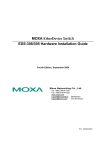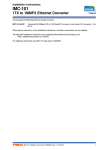Download Moxa Technologies ETHERDEVICE EDS-305 Installation guide
Transcript
MOXA EtherDevice Switch & PoE Splitter EDS-P308 & SPL-24 Hardware Installation Guide First Edition, July 2006 Moxa Networking Co., Ltd. Tel: +886-2-2910-1230 Fax: +886-2-2910-1231 www.moxa.com [email protected] [email protected] (Worldwide) (The Americas) P/N: 1802003080000 Overview We describe two products in this manual: The MOXA EtherDevice™ EDS-P308 is an 8-port smart Ethernet switch that provides an economical solution for your Ethernet connections. The switch supports PoE (Power-over-Ethernet) on ports 1 to 4, which means that the EDS-P308 can double as a piece of power source equipment (PSE). When used in this way, the EDS-P308 can supply up to 15.4 watts of power per port, and can power IEEE 802.3af compliant powered devices (PD), eliminating the need for additional wiring. As an added bonus, the built-in smart alarm function helps system maintainers monitor the health of your Ethernet network. The SPL-24 plays the role of PD, and splits the data signal and power signal that are transmitted from the PSE. The SPL-24 plays a dual role of providing power to industrial devices, and enabling Ethernet connections. The EDS-P308 and SPL-24 have a wide operating temperature range of -40 to 75°C, and are designed to withstand a high degree of vibration and shock. The rugged hardware design makes the EDS-P308 and SPL-24 perfect for ensuring that your Ethernet equipment can operate in critical industrial environments, such as in hazardous locations, and complies with FCC and CE standards. The installation of the EDS-P308 is presented on pages 3 to 10. The installation of the SPL-24 is presented on pages 11 to 14. NOTE Throughout this Hardware Installation Guide, we use EDS as an abbreviation for MOXA EtherDevice Switch, and we use SPL as an abbreviation for MOXA PoE Splitter: EDS = MOXA EtherDevice Switch SPL = MOXA PoE Splitter MOXA’s PoE Solution S61122:36 DR-120-48 E215312 LISTED IND. CONT. EQ. 94A0 48 VDC input Wireless Access Point AWK-1100 Data on Ethernet 24 VDC output Data on Ethernet EDS-P308 Legend: Ethernet Power Power over Ethernet SPL-24 MOXA provides a complete end-to-end solution for any IEEE 802.3af PoE compliant unit and Ethernet-enabled device. The EDS-P308 and SPL-24 can be used to simplify wiring in the field, and provide a more versatile — 1 — environment for installing devices. PoE technology lets you eliminate the need for using power outlets to deploy Ethernet-enabled devices—such as a wireless access point (AP) or an IP camera—on a ceiling or outdoors. The devices can be placed up to 328 feet (100 m) from a PSE. Wiring Requirements WARNING Do not disconnect modules or wires unless the power supply has been switched off or the area is known to be non-hazardous. The devices may only be connected to the supply voltage shown on the type plate. The devices are designed for operation with a Safety Extra-Low Voltage. Thus, they may only be connected to the supply voltage connections and to the signal contact with the Safety Extra-Low Voltages (SELV) in compliance with IEC950/ EN60950/ VDE0805. WARNING The power for this product is intended to be supplied by a Listed Power Unit, with output marked LPS, and rated to deliver 48 VDC at a maximum of 300 mA. WARNING This unit is a built-in type. When the unit is installed in another piece of equipment, the equipment enclosing the unit must comply with fire enclosure regulation IEC 60950/EN60950 (or similar regulation). WARNING Safety First! Be sure to disconnect the power cord before installing and/or wiring your MOXA EtherDevice Switch. Calculate the maximum possible current in each power wire and common wire. Observe all electrical codes dictating the maximum current allowable for each wire size. If the current goes above the maximum ratings, the wiring could overheat, causing serious damage to your equipment. You should also pay attention to the following items: y Use separate paths to route wiring for power and devices. If power wiring and device wiring paths must cross, make sure the wires are perpendicular at the intersection point. y NOTE: Do not run signal or communications wiring and power wiring in the same wire conduit. To avoid interference, wires with different signal characteristics should be routed separately. y You can use the type of signal transmitted through a wire to determine which wires should be kept separate. The rule of thumb is that wiring that shares similar electrical characteristics can be bundled together. y Keep input wiring and output wiring separated. y It is strongly advised that you label wiring to all devices in the system when necessary. — 2 — Package Checklist for EDS-P308 The MOXA EDS-P308 is shipped with the following items. If any of these items is missing or damaged, please contact your customer service representative for assistance. y y y y MOXA EtherDevice™ Switch EDS-P308 Hardware Installation Guide MOXA Product Warranty Statement Protective caps for unused ports Features of EDS-P308 High Performance Network Switching Technology y 10/100BaseT(X) (RJ45) y IEEE802.3/802.3u/802.3x y Store and Forward switching process type, with 1024 address entries y 10/100M, Full/Half-Duplex, MDI/MDIX auto-sensing y Provides up to 15.4 watts per PoE port y Active circuit protection y Auto disconnection for over voltage or under voltage y Power consumption detection and classification Industrial Grade Reliablity y Power failure, port break alarm by relay output y Redundant dual DC power inputs Rugged Design y Operating temperature range from 0 to 60°C, or extended operating temperature from -40 to 75°C for “-T” models y IP30, rugged high-strength case y DIN-Rail or panel mounting ability Specifications of EDS-P308 Technology Standards Forward and Filtering Rate Packet Buffer Memory Processing Type Address Table Size Latency Interface RJ45 Ports LED Indicators DIP Switch Alarm Contact IEEE802.3, 802.3u, 802.3x, 802.3af 148810 pps 256 KB Store and Forward, with IEEE802.3x full duplex, back pressure flow control 1,000 uni-cast addresses Less than 5 μs 10/100BaseT(X) auto negotiation speed, F/H duplex mode, and auto MDI/MDI-X connection Power, Fault, 10/100, PoE Port break alarm mask One relay output with current carrying capacity of 0.5A @ 48 VDC — 3 — Power Input Voltage Input Current Connection Overload Current Protection Reverse Polarity Protection 48 VDC, redundant inputs 1.6 A (@ 48 VDC) Removable “6-pin” Terminal Block 2.5 A (@ 48 VDC) Present PoE (per port) Minimum output voltage Maximum output current Inrush current Overload detection Output current in short circuit condition Overload and short circuit time limit Turn off time Turn off voltage Maximum Output Power 500 ms 2.8V 15.4W Mechanical Casing Dimensions Weight Installation IP30 protection, metal case 53.6 × 135 × 105 mm (W × H × D) 0.84 kg DIN-Rail, Wall Mounting Environmental Operating Temperature Storage Temperature Ambient Relative Humidity 44 VDC 350 mA (@ 48V, normal powering mode) 400 to 450 mA (startup mode) 400 mA (max.) 400 to 450 mA 50 to 75 ms 0 to 60°C (32 to 140°F) -40 to 75°C (-40 to 167°F) for -T models -40 to 85°C (-40 to 185°F) 5 to 95% (non-condensing) Regulatory Approvals Safety Pending: UL60950, UL 508, CSA C22.2 No. 60950, EN60950 Hazardous Location Pending: UL/cUL Class I, Division 2, Groups A, B, C and D Pending: ATEX Class I, Zone 2, EEx nC IIC EMI FCC Part 15, CISPR (EN55022) class A EMS EN61000-4-2 (ESD), Level 3 EN61000-4-3 (RS), Level 3 EN61000-4-4 (EFT), Level 3 EN61000-4-5 (Surge), Level 3 EN61000-4-6 (CS), Level 3 Shock IEC60068-2-27 Freefall IEC60068-2-32 Vibration IEC60068-2-6 WARRANTY 5 years — 4 — EDS-P308 Panel Layout Top Panel View 1. 2. 1 Grounding screw Terminal block for power inputs PWR1, PWR2, and relay output 3. 2 3 1 2 ON DIP switches 5. Power input PWR1 LED 6. Power input PWR2 LED 7. Fault LED 8. 10/100BaseT(X) Port 3 4 5 6 4 Heat dissipation orifices 4. 8 DIP 7 Front Panel View 2 5 6 7 9. TP port’s 100 Mbps LED 10. TP port’s 10 Mbps LED 11. Model Name 12. Screw holes for wall mounting kit 13. DIN-Rail Kit 14. PoE port LEDs (ports 1 to 4) 14 8 9 10 11 Rear Panel View 2 1 12 13 12 — 5 — Mounting Dimensions (unit = mm) 30.00 9.00 15.10 19.80 13.10 25.40 135.00 135.00 35.00 DlN-Rail DlN-Rail Kit 105.00 Front View 3.5 Side View 6 + + 18 13.9 10 10 5 13 46.77 27.20 48.30 39.37 13 18.2 57.05 25.71 13.9 66.80 6 23.15 DlN-Rail Kit + + 7.75 30.50 7.75 53.60 Rear View Wall Mounting Kit DIN-Rail Mounting The aluminum DIN-Rail attachment plate should already be fixed to the back panel of the EDS-P308 when you take it out of the box. If you need to reattach the DIN-Rail attachment plate, make sure the stiff metal spring is situated towards the top, as shown in the figures below. STEP 1: STEP 2: Insert the top of the DIN-Rail into the The DIN-Rail attachment unit will slot just below the stiff metal spring. snap into place as shown below. metal spring metal spring DIN-Rail DIN-Rail To remove the MOXA EtherDevice Switch from the DIN-Rail, simply reverse Steps 1 and 2 above. — 6 — Wall Mounting (optional) For some applications, you will find it convenient to mount EDS-P308 on the wall, as illustrated below. STEP 1: Remove the aluminum DIN-Rail attachment plate from the EDS-P308’s rear panel, and then attach the wall mount plates, as shown in the diagram below. top plate ⇒ bottom plate STEP 2: 6.0 mm Mounting the EDS-P308 on the wall requires 4 screws. Use the switch, with wall mount plates attached, as a guide to mark the correct locations of the 4 screws. The heads of the screws should be less than 6.0 mm in diameter, and the shafts should be less than 3.5 mm in diameter, as shown in 3.5 mm the figure at the right. NOTE Before tightening the screws into the wall, make sure the screw head and shank size are suitable by inserting the screw into one of the keyhole-shaped apertures of the wall mounting plates. Do not screw the screws in all the way—leave about 2 mm to allow room for sliding the wall mount panel between the wall and the screws. STEP 3: Once the screws are fixed in the wall, insert the four screw heads through the large parts of the keyhole-shaped apertures, and then slide the EDS-P308 downwards, as indicated. Tighten the four screws for added stability. ⇒ Grounding the EDS-P308 Grounding and wire routing help limit the effects of noise due to electromagnetic interference (EMI). Run the ground connection from the ground screw to the grounding surface prior to connecting devices. ATTENTION This product is intended to be mounted to a well-grounded mounting surface, such as a metal panel. — 7 — EDS-P308’s Redundant Power Inputs Both power inputs can be connected simultaneously to live DC power sources. If one power source fails, the other live source acts as a backup, and automatically supplies all of EDS-P308’s power needs. Wiring the Redundant Power Inputs The top two contacts and the bottom two contacts of the 6-contact terminal block connector on EDS’s top panel are used for EDS’s two DC inputs. Top and front views of one of the terminal block connectors are shown here. STEP 1: Insert the negative/positive DC wires into the V-/V+ terminals. Top View STEP 2: To keep the DC wires from pulling loose, use a small flat-blade screwdriver to tighten the wire-clamp screws on the front of the terminal block connector. Front View STEP 3: Insert the plastic terminal block connector prongs into the terminal block receptor, which is located on EDS’s top panel. ATTENTION Before connecting EDS to the DC power inputs, make sure the DC power source voltage is stable. EDS-P308’s Alarm Contact The EDS-P308 has one alarm contact located on its top panel. For detailed instructions on how to connect the alarm contact power wires to the two middle contacts of the 6-contact terminal block connector, see the Wiring the Alarm Contact section on page 9. A typical scenario would be to connect the Fault circuit to a warning light located in the control room. The light can be set up to switch on when a fault is detected. The alarm contact has two terminals that form a Fault circuit for connecting to an alarm system. The two wires attached to the Fault contacts form an open circuit when (1) EDS has lost power from one of the DC power inputs, or (2) one of the ports for which the corresponding PORT ALARM DIP Switch is set to ON is not properly connected. If neither of these two conditions occurs, the Fault circuit will be closed. — 8 — EDS-P308’s DIP Switch Settings ON 1 2 DIP 3 4 5 6 7 8 ON: Enables the corresponding PORT Alarm. If the port’s link fails, the relay will form an open circuit and the fault LED will light up. Off: Disables the corresponding PORT Alarm. The relay will form a closed circuit and the Fault LED will never light up. Wiring the Alarm Contact The alarm contact consists of the two middle contacts of the terminal block on EDS’s top panel. Refer to page 8 for detailed instructions on how to connect the wires to the terminal block connector, and how to attach the terminal block connector to the terminal block receptor. In this section, we explain the meaning of the two contacts used to connect the alarm contact. FAULT Top View FAULT Front View FAULT: The two middle contacts of the 6-contact terminal block connector are used to detect both power faults and port faults. The two wires attached to the Fault contacts form an open circuit when: 1. EDS has lost power from one of the DC power inputs. OR 2. One of the ports for which the corresponding PORT ALARM DIP Switch is set to ON is not properly connected. If neither of these two conditions is satisfied, the Fault circuit will be closed. — 9 — LED Indicators The front panel of the EDS-P308 contains several LED indicators. The function of each LED is described in the table below. LED PWR1 PWR2 FAULT 10M 100M PoE Color State On Off Power is not being supplied to power input PWR1 On Power is being supplied to power input PWR2 Off Power is not being supplied to power input PWR2 On When the corresponding PORT alarm is enabled, and the port’s link is inactive. Off When the corresponding PORT alarm is enabled and the port’s link is active, or when the corresponding PORT alarm is disabled. On TP port’s 10 Mbps link is active AMBER AMBER RED GREEN GREEN Description Power is being supplied to power input PWR1 Blinking Data is being transmitted at 10 Mbps Off TP Port’s 10 Mbps link is inactive On TP port’s 100 Mbps link is active Blinking Data is being transmitted at 100 Mbps Off 100BaseTX Port’s link is inactive On PD is connected and power is being supplied. Off PD is not connected or power is not supplied. AMBER — 10 — Package Checklist for SPL-24 The MOXA SPL-24 is shipped with the following items. If any of these items is missing or damaged, please contact your customer service representative for assistance. y MOXA PoE Splitter, SPL-24 y Hardware Installation Guide y MOXA Product Warranty Statement Features of SPL-24 High Performance Network Switching Technology y IEEE802.3af compliance y Power/data split from PoE lines using either spare-pairs or data pairs y Support for up to 12.95W at 24 VDC y Support for up to 15.4 watts per PoE port y Short circuit protection y Auto disconnection for over voltage or under voltage y Power consumption detection and classification Rugged Design y Operating temperature range from 0 to 60°C, or extended operating temperature from -40 to 75°C for “-T” models y IP30, plastic case y DIN-Rail or panel mounting ability Specifications of SPL-24 Technology Standards Interface RJ45 Ports LED Indicators Power Input Voltage Output voltage Output power Connection Overload current protection Efficiency Mechanical Casing Dimensions Weight Installation Environmental Operating Temperature Storage Temperature IEEE802.3af 10/100BaseT(X) for PoE IN, and 10/100BaseT(X) for DATA OUT Power 44 to 75 VDC 24 12.95W (0.54A @ 24 VDC) Removable “3-pin” Terminal Block for output 400 mA (@ 48 VDC input) 89% (at 60°C, fully-loaded) IP30 protection, plastic case 24.87 × 109 × 88 mm (W × H × D) 95 g DIN-Rail, Wall Mounting 0 to 60°C (32 to 140°F) -40 to 75°C (-40 to 167°F) for -T models -40 to 85°C (-40 to 185°F) — 11 — Ambient Relative Humidity 5 to 95% (non-condensing) Regulatory Approvals Safety Pending: UL60950, UL 508, CSA C22.2 No. 60950, EN60950 Hazardous Location Pending: UL/cUL Class I, Division 2, Groups A, B, C, and D Pending: ATEX Class I, Zone 2, EEx nC IIC EMI FCC Part 15, CISPR (EN55022) class A EMS EN61000-4-2 (ESD), Level 3 EN61000-4-3 (RS), Level 3 EN61000-4-4 (EFT), Level 3 EN61000-4-5 (Surge), Level 3 EN61000-4-6 (CS), Level 3 Shock IEC60068-2-27 Free Fall IEC60068-2-32 Vibration IEC60068-2-6 WARRANTY 5 years SLP-24 Panel Layout Top View Front View Rear View 2 1 3 P 4 DATA OUT 2 V+ 5 OUTPUT : 24 VDC 7 PoE IN 6 1. Heat dissipation orifices 2. Terminal block for power input and grounding 3. MOXA Logo 4. PoE power LED 5. DATA-OUT port 6. PoE IN port 7. DIN-Rail kit — 12 — Mounting Dimensions (unit = mm) 74 15 32 10.5 24.87 P 74 V+ 100 76.2 100 DATA OUT OUTPUT : 24 VDC PoE IN 86.5 24.87 Side View Front View Rear View Top View DIN-Rail Mounting for SPL-24 The plastic DIN-Rail attachment plate should already be fixed to the back panel of SPL-24 when you take it out of the box. If you need to reattach the DIN-Rail attachment plate, make sure the stiff metal spring is situated towards the top, as shown in the figures below. STEP 1: STEP 2: Insert the top of the DIN-Rail into the The DIN-Rail attachment unit will slot. snap into place as shown below. To remove the SPL-24 from the DIN-Rail, insert a flat-blade screw driver horizontally into the DIN-Rail kit under the SPL-24, and then pull it upwards and release SPL-24 towards you away from the DIN-Rail. — 13 — Grounding the SPL-24 Grounding and wire routing help limit the effects of noise due to electromagnetic interference (EMI). Run the right most contact of the 3-contact terminal block to the grounding surface prior to connecting devices. ATTENTION This product is intended to be mounted to a well-grounded mounting surface, such as a metal panel. Wiring the SPL-24’s Power Outputs The two left-most contacts of the 3-contact terminal block connector on the SPL-24’s top panel are used for 24 VDC output. Top and front views of one of the terminal block connectors are shown here. STEP 1: Insert the negative/positive DC wires into the V-/V+ terminals. STEP 2: To keep the DC wires from pulling loose, use a small flat-blade screwdriver to tighten the wire-clamp screws on the front of the terminal block connector. STEP 3: Insert the plastic terminal block connector prongs into the terminal block receptor, which is located on SPL-24's top panel. — 14 — MOXA Internet Services Customer satisfaction is our number one concern, and to ensure that customers receive the full benefit of our products, Moxa has set up on-line support services to provide technical support, driver updates, product information, and user’s manual updates. E-mail for technical support: [email protected] [email protected] Website for up to date product information: www.moxa.com — 15 — (Worldwide) (The Americas)


























